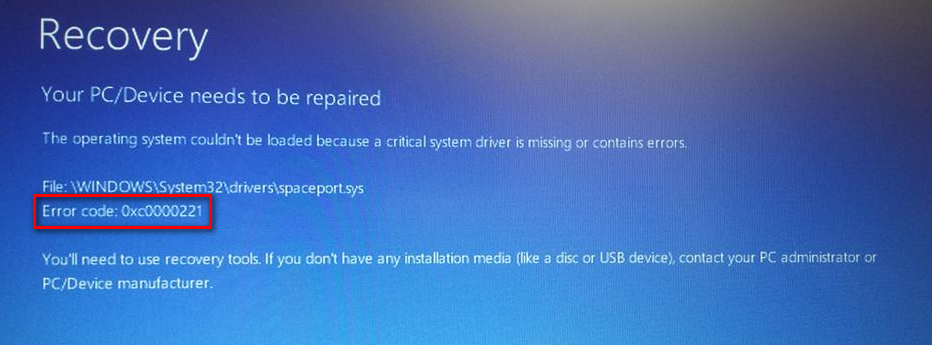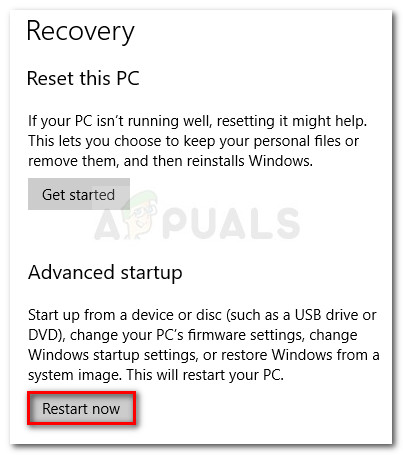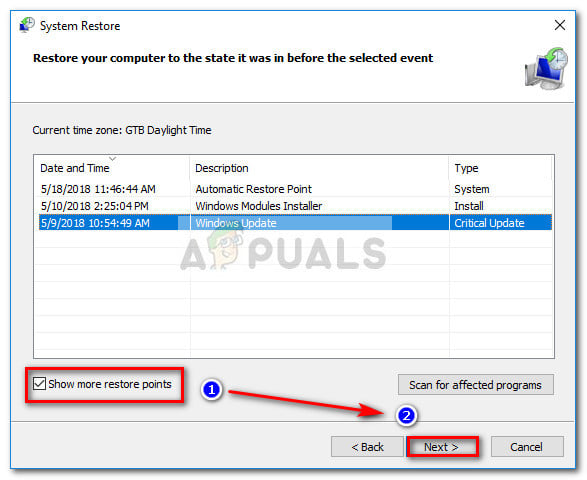How to Fix PC/Device Repair Error 0xc0000221
Your PC/Device needs to be repaired
Typically, the 0xc0000221 error code is encountered right after the computer fails to boot. Most users report that this doesn’t happen at every boot attempt, but several users report being stuck in an Automatic Repair Loop with this error code.

Error codes starting with ‘0x’ usually point towards a system-level corruption problem. However, with this particular error code, the error can also be hardware-related (a newly inserted RAM or insufficient power).
What is causing the 0xc0000221 error code?
After investigating the issue and looking at a lot of different symptoms of the same error, we discovered a couple of different culprits that might generate the 0xc0000221 error code:
- Hardware issue created by new RAM or hard drive – There are a couple of reported cases where users started receiving this error after inserting a second RAM stick or connecting a new slave HDD.
- Secondary GPU – The issue is sometimes reported on computers that have an SLI or CrossFire setup.
- Power supply not capable of delivering enough power – This behavior might occur if your power supply is not large enough to sustain all connected devices.
- System file corruption – The error code points towards a system-level problem that has to do with file corruption.
- Third party service is interrupting startup – There are reported cases where the error was triggered by a rogue third-party service that ended up producing a BSOD crash.
How to fix the 0xc0000221 error code
If you’re actively looking for some troubleshooting steps to help you circumvent the 0xc0000221 error code, we made it easier for you. Below you have a collection of potential fixes that other users in a similar scenario have used successfully to get the issue resolved.
For the best results, follow the methods below in the presented order as they are ordered by efficiency and severity. Start with the first method and work your way down to the next until you find a fix that is effective in resolving the issue for you.
Method 1: Booting in Safe Mode
Let’s start our troubleshooting quest by making sure that the issue is not facilitated by a rogue service that is facilitating the BSOD crash. We can make sure that the issue is not caused by third-party interference by booting your system into Safe Mode.
While in Safe Mode, your computer will start in a limited state with only the basic files and drivers needed for the Startup process. If your computer boots just fine into Safe Mode, we can determine that the issue is facilitated by some software you previously installed.
Here’s a quick guide on booting in Safe Mode and identifying the process that is causing the BSOD crash:
- If you are unable to get past the startup screen, you can force the apparition of the Advanced Startup Options screen by forcing two or three consecutive interruptions during the startup process. You can do this easily by restarting your PC during the startup phase.

Cause 3 consecutive startup interruptions to reach the Advanced Startup menu Note: If you are able to complete the booting process, you can also open the Settings Recovery tab by opening a Run dialog (Windows key + R) and typing “ms-settings:recovery“. Then, simply click the Restart now button under Advanced startup and your computer will restart straight into the Advanced Startup Options menu.

Restart in the Advanced Startup Options menu - From the Advanced Startup Options screen, select Troubleshoot and then click on Advanced options.
- Inside Advanced options, click on Startup Settings and then click the Restart button.

Click Restart to bring up the Startup Settings menu - When you get to the Startup Settings again, press F4, F5 or F6 to boot with one of the three Safe Modes available.
- If your computer boots successfully into Safe Mode, it’s likely that service from an application that you recently installed is causing the BSOD. At this point, you can start uninstalling recently installed programs that you feel could be causing the issue or you can use this guide (here) to systematically exclude programs and services from the startup process until you manage to find your culprit.
If you got the same BSOD crash while booting in Safe Mode, continue down with the next method below.
Method 2: Perform an SFC, CHKDSK and DISM scan
Now let’s make sure that the 0xc0000221 error code is not occurring due to a system file corruption by running a couple of built-in utilities designed to fix Windows file corruption.
Several users struggling with the same issue have managed to get the issue resolved by resolving system file corruption via SFC, CHKDSK or DISM scans. This procedure might take a while, so please arm yourself with patience and don’t interrupt the process until it’s complete.
Here’s a quick guide on performing SFC and DISM scans:
- Press Windows key + R to open up a Run dialog box. Then, type “cmd” and press Ctrl + Shift + Enter to open up an elevated Command Prompt. When prompted by the UAC (User Account Control), choose Yes to grant admin privileges.

Run dialog: cmd and press Ctrl + Shift + Enter Note: If you are unable to get past the startup screen, follow step 1 from Method 1 to get into the Advanced Startup Options menu, then go to Troubleshoot > Advanced Options > Command Prompt.
- In the elevated Command Prompt, type the following command to initiate an SFC scan:
sfc /scannow
Note: This utility will scan your system for corruption and replace corrupted Windows file with locally cached copies.
- Once the process is complete, restart your computer and see if the error code 0xc0000221 is no longer appearing. If it still is, follow step 1 again to return to an elevated Command prompt and type in the following command:
chkdsk /f C:
Note: This utility will perform an analysis on your disk and repair any errors it manages to find. Keep in mind that you need to change C to your drive letter if your OS is located somewhere else.
- When the repair strategy is complete, reboot your machine and see if you manage to get past the startup screen. If the same error repeats, return to the elevated Command Prompt using step 1 and type in the following command:
dism /online /cleanup-image /restorehealth
Note: This utility will replace any corrupted Windows file with fresh copies downloaded from Microsoft’s server. It’s important that you have a stable internet connection before initiating this scan.
- Restart your computer and see if the error is resolved at the next startup, if it isn’t, continue down with the next method below.
Method 3: Verifying RAM for issues
RAM sticks are often identified as culprits when it comes to the 0xc0000221 error code. RAM issues can be tricky to identify as even some of the best testing utilities might fail to catch all errors such as mismatched memory errors.
The best and easiest strategy of verifying if your RAM modules are responsible for the error is to open up your PC and remove one of the modules (if you’re using two RAM sticks).
If your computer is starting up just fine with only one RAM stick, try swapping the position of the two RAM sticks – issues sometimes occur when the faster memory is placed behind the slower memory.
If you are suspecting problems with one or both your RAM modules, you can run a MemTest on them – but make sure you let it run for at least 5 hours in order to obtain a conclusive result.
If you managed to clear your RAM modules from the culprit list, continue down with the next method below.
Method 4: Removing secondary GPU and external HDDs or SSDs
Other users have reported being successful in eliminating the error code 0xc0000221 by disconnecting all unnecessary devices. It’s entirely possible that this issue is occurring because your power supply doesn’t have enough power to sustain all connected devices.
Let’s test whether this theory holds true by disconnecting every unnecessary device – secondary HDD, external HDD, DVD optical drive, second GPU from SLI (or CrossFire setup), non-critical peripherals.
Once your PC is stripped to the bare minimum, power up your computer and see if the system manages to get past the startup screen. If your computer manages to boot up without the error code 0xc0000221, systematically re-connect the non-essential components until you manage to identify the culprit.
If this method wasn’t applicable, continue down with the next method below.
Method 5: Using a previous System Restore point
Several users have reported that this issue started occurring right after Windows Update (WU) completed the installation of a big OS Update. If a botched Windows Update is triggering random BSOD crashes with the error code 0xc0000221, you might be able to get the issue resolved by using a System Restore point.
System Restore is a Windows feature that will allow you to fix a wide array of crashes by restoring your machine state to a previous point in time. With a little bit of luck, we are going to use it to restore the computer to a healthy state in which the error code 0xc0000221 was not occurring.
Unless you modified the default behavior yourself, your OS should have created a System Restore point right before the update responsible for the error was applied. Here’s a quick guide on using the System Restore feature to resolve the error code 0xc0000221:
- Press Windows key + R to open up a Run dialog box. Then, type “rstrui” and press Enter to open up the System Restore wizard.

Run dialog: rstrui - In the first System Restore screen, click Next to advance to the Restore Point section.
- In the next screen, make sure to tick the checkbox associated with Show more restore points in order to view every available Restore point.

Enable Show more restore points box and click Next - Then, select a restore point that is older than the apparition of the 0xc0000221 error code and click the Next button again.
- Click on Finish and confirm a final time by clicking on Yes to kickstart the System Restoring process.
- After a couple of minutes, your computer will restart and the older state will be restored. If all goes well, your machine should no longer crash with the 0xc0000221 error code.
If you didn’t have an appropriate System Restore point or this method wasn’t applicable, continue down with the next method below.
Method 6: Performing a repair install
If none of the methods presented above have allowed you to circumvent the 0xc0000221 error, you might have to start considering a clean install. But before you do so and lose all your personal data, there’s a better option that will allow you to preserve your personal files and applications.
A repair install will replace any broken Windows components that might be triggering the error with fresh copies. But as opposed to a clean install, a repair install will not delete user personal files (such as photos, music, videos) or third party applications.
If you decide to do a repair install, you can follow our step-by-step guide using this guide (here).





